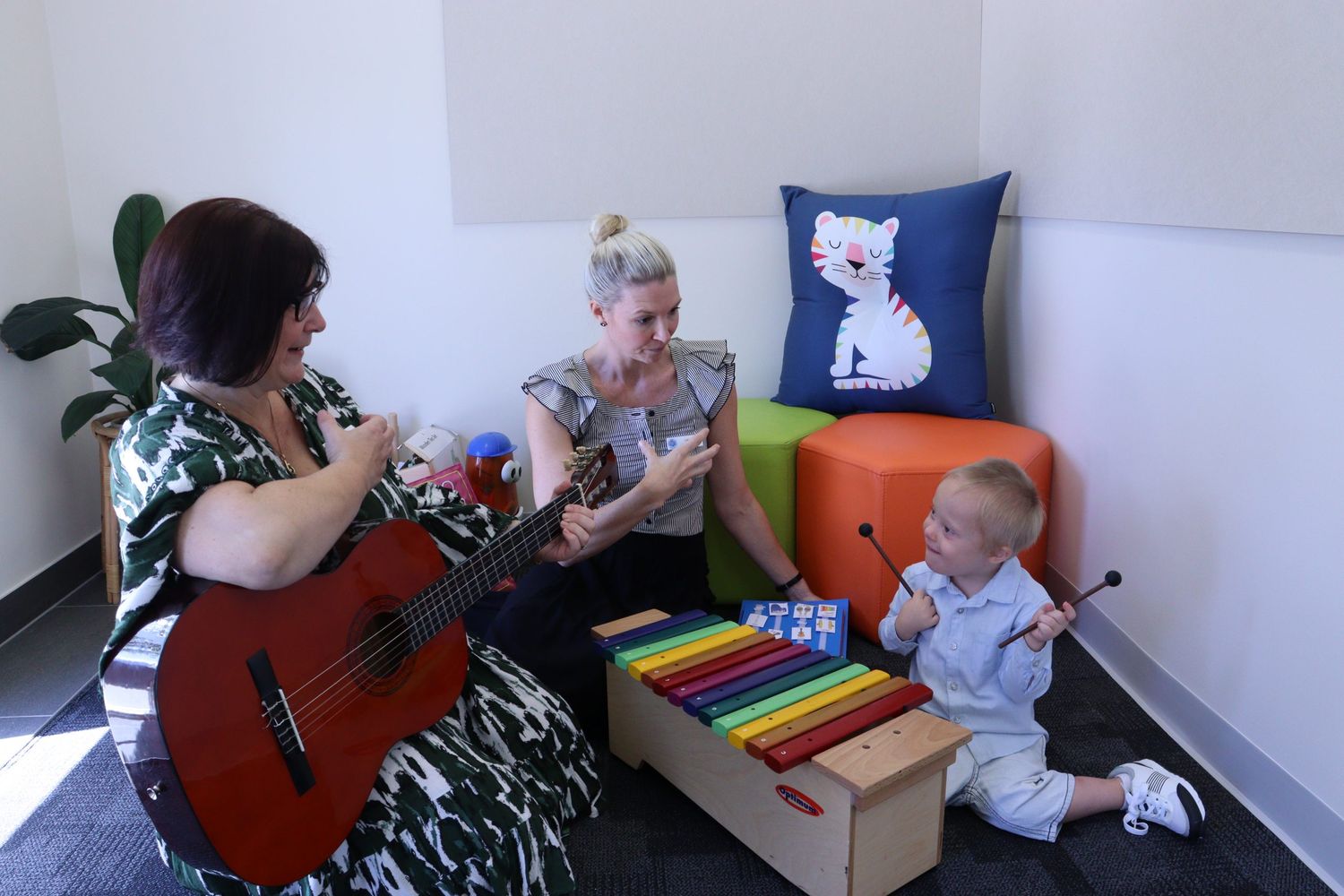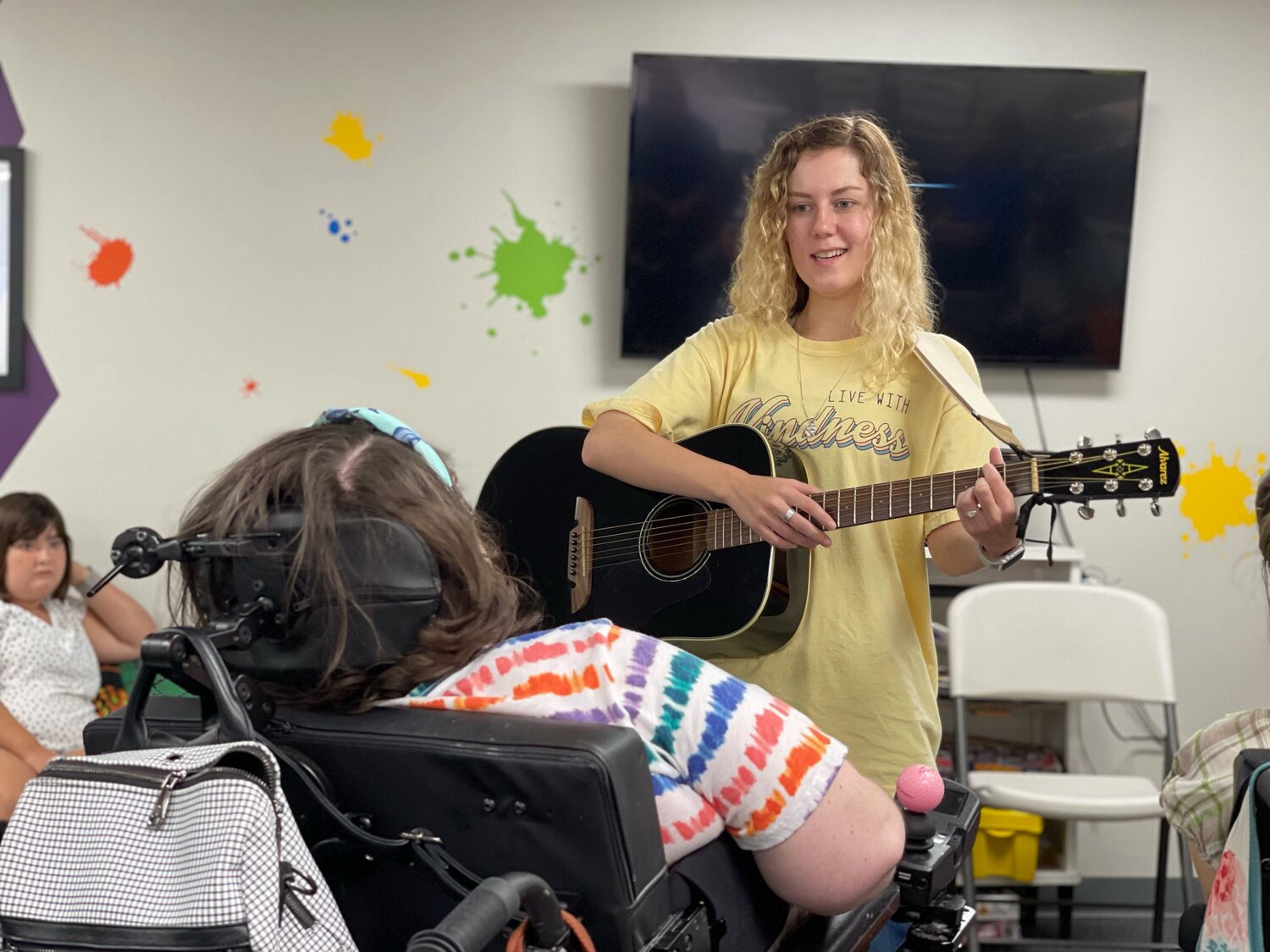Home>Events & Info>Music Therapy>What Type Of Therapy Is Music Therapy


Music Therapy
What Type Of Therapy Is Music Therapy
Modified: February 2, 2024
Discover the power of music therapy for healing and self-expression. Explore the various types of therapy and how they can improve mental and emotional well-being.
(Many of the links in this article redirect to a specific reviewed product. Your purchase of these products through affiliate links helps to generate commission for AudioLover.com, at no extra cost. Learn more)
Table of Contents
- Introduction
- Definition of Music Therapy
- The Power of Music in Healing
- The Role of a Music Therapist
- Techniques and Approaches Used in Music Therapy
- Benefits of Music Therapy
- Conditions and Disorders Treated by Music Therapy
- Case Studies and Success Stories in Music Therapy
- Considerations and Limitations of Music Therapy
- Integration of Music Therapy with Other Therapeutic Approaches
- Conclusion
Introduction
Music has been a source of solace, joy, and inspiration for centuries. Its powerful impact on our emotions and well-being is undeniable. From ancient civilizations to modern times, music has been used to heal and uplift the spirit. And this is where music therapy comes into play.
Music therapy is a unique and growing field that utilizes the therapeutic power of music to promote healing, improve mental health, and enhance overall well-being. It involves the use of music interventions by trained professionals, known as music therapists, to address physical, emotional, cognitive, and social needs of individuals of all ages and abilities.
The premise of music therapy lies in the belief that music has the ability to engage and stimulate the brain in profound ways. As we listen to or create music, it activates various regions of the brain, releasing neurochemicals and triggering emotional responses that can have a positive impact on our mental and physical health.
Music therapists have a deep understanding of how music can be used as a therapeutic tool. They are trained to assess individual needs, develop personalized treatment plans, and facilitate music-based interventions to address specific goals. These interventions may include listening to music, playing musical instruments, singing, songwriting, improvisation, and movement to music.
Music therapy can be beneficial for individuals of all ages, from newborns to the elderly, and can be used in a variety of settings, such as hospitals, schools, nursing homes, mental health facilities, and rehabilitation centers. It can be effective as a stand-alone therapy or as an adjunct to other therapeutic approaches, complementing medical and psychological interventions.
In the following sections, we will dive deeper into the world of music therapy, exploring its principles, techniques, benefits, limitations, and its integration with other therapeutic approaches. Through a comprehensive understanding of music therapy, we hope to shed light on the profound impact music can have on our physical and emotional well-being.
Definition of Music Therapy
Music therapy is a field of healthcare that utilizes music as a therapeutic tool to address the physical, emotional, cognitive, and social needs of individuals. It is based on the understanding that music has a profound impact on our well-being and can be used to promote healing and improve overall health.
The American Music Therapy Association (AMTA) defines music therapy as “the clinical and evidence-based use of music interventions to accomplish individualized goals within a therapeutic relationship by a credentialed professional who has completed an approved music therapy program.”
What sets music therapy apart from simply listening to music or playing an instrument is the presence of a trained and certified music therapist who utilizes specific techniques and approaches to meet the individual needs of the client. Music therapists are skilled in assessing the client’s strengths and challenges and developing customized treatment plans to address their unique goals.
Music therapy is a holistic approach that addresses the whole person: mind, body, and spirit. It recognizes the interconnectedness of these aspects and seeks to promote balance and well-being. Whether through active participation in music-making or passive engagement with music, the therapeutic effects of music can be experienced on various levels.
It’s important to note that music therapy is different from music entertainment or music lessons. While music lessons focus on teaching musical skills, music therapy is centered around using music as a tool for achieving therapeutic goals. It is a collaborative process between the music therapist and the client, where music is utilized to address specific needs and facilitate personal growth and healing.
Music therapy can be beneficial for individuals of all ages and can be tailored to suit various populations, including infants, children, adolescents, adults, and older adults. It can be utilized in a wide range of settings, including hospitals, schools, mental health clinics, rehabilitation centers, and community settings.
Now that we have a clearer understanding of what music therapy entails, let’s explore the powerful healing properties of music and how it can positively impact our well-being.
The Power of Music in Healing
Music has a unique ability to touch our emotions, evoke memories, and create a powerful connection between our minds and bodies. It has been used for centuries as a means of expression and communication, and its therapeutic benefits are well-documented.
One of the most remarkable aspects of music is its ability to bypass cognitive barriers and directly access our emotions. When we listen to music that resonates with us, it has the power to evoke a range of emotions, from joy and happiness to sadness and nostalgia. This emotional response can be incredibly powerful and can facilitate healing on a deep level.
Music can also have a profound impact on our physical well-being. Research has shown that engaging with music can lead to physiological responses such as changes in heart rate, blood pressure, and respiration. In fact, studies have demonstrated that listening to calming music can reduce stress and anxiety, lower blood pressure, and even alleviate pain.
In addition to its emotional and physical effects, music also has cognitive benefits. It can stimulate the brain, improve focus and attention, enhance memory and learning, and promote overall cognitive functioning. This is particularly beneficial for individuals with cognitive impairments or neurological conditions, as music can provide a means of engagement and communication.
Furthermore, music has a social component that can promote a sense of belonging and connection. Group music therapy sessions can foster social interaction, encourage communication, and promote interpersonal skills. This is especially beneficial for individuals with autism spectrum disorder, developmental disabilities, or social anxiety.
Whether it’s through active participation in music-making, such as playing an instrument or singing, or through passive engagement with music, such as listening or guided imagery, the power of music in healing is undeniable. It has the ability to uplift our spirits, provide comfort during difficult times, and create a sense of well-being.
Music therapy harnesses this power to create a therapeutic environment where individuals can explore emotions, express themselves, and work towards their personal goals. Music therapists are trained to select or create music that is tailored to the individual’s needs and preferences, allowing them to engage with the music in a way that is meaningful to them.
By understanding the power of music in healing, we can begin to appreciate the transformative potential of music therapy. In the next section, we will delve into the role of a music therapist and how they utilize music to facilitate healing and growth.
The Role of a Music Therapist
A music therapist is a trained professional who holds a degree in music therapy and has completed a supervised clinical internship. They have a deep understanding of the therapeutic applications of music and are skilled in assessing the needs of their clients and developing appropriate treatment plans.
The primary role of a music therapist is to utilize music as a tool for therapeutic intervention. They work closely with their clients to identify their goals, strengths, and challenges, and then design personalized treatment plans that incorporate various music-based interventions.
One of the key responsibilities of a music therapist is to establish a therapeutic relationship with their clients. This involves creating a safe, supportive, and non-judgmental environment in which the client feels comfortable expressing themselves and engaging with the music. The therapist builds trust and rapport with the client, enabling them to explore their emotions and experiences through music.
Assessment is another crucial aspect of the music therapist’s role. They gather information about the client’s background, interests, and musical preferences to understand their unique needs and tailor the therapy accordingly. They may use standardized assessments, observations, interviews, and music-based activities to assess the client’s abilities, strengths, and areas of growth.
Based on the assessment, the music therapist develops individualized treatment plans. These plans outline the goals of therapy and the specific interventions that will be used to address those goals. The interventions can include activities such as listening to music, playing musical instruments, singing, songwriting, improvisation, movement to music, and guided imagery.
During the therapy sessions, the music therapist guides and facilitates the client’s engagement with the music. They encourage active participation, provide support and feedback, and adapt the interventions as needed to meet the client’s evolving needs. The therapist also documents the progress and evaluates the effectiveness of the interventions, making adjustments as necessary.
Collaboration and communication are essential skills for a music therapist. They work closely with other healthcare professionals, educators, and caregivers to ensure a holistic approach to the client’s care. The therapist may participate in interdisciplinary meetings, provide recommendations for integrating music therapy into other treatment plans, and offer support and education to other team members.
Continuing education and professional development are crucial for a music therapist to stay up-to-date with the latest research and techniques in the field. They may attend conferences, workshops, and training programs to expand their knowledge and skills.
Overall, the role of a music therapist is to facilitate meaningful and therapeutic experiences through music. They create a safe space for individuals to explore their emotions, enhance their self-expression, improve their communication skills, and work towards their goals of healing and growth.
Now that we have explored the role of a music therapist, let’s delve into the different techniques and approaches used in music therapy.
Techniques and Approaches Used in Music Therapy
Music therapy involves a wide range of techniques and approaches that are tailored to meet the unique needs and goals of each individual client. These techniques utilize the power of music to address physical, emotional, cognitive, and social needs. Let’s explore some of the commonly used techniques and approaches in music therapy.
- Listening to Music: Passive engagement with music is a fundamental aspect of music therapy. Music therapists carefully select music that is soothing, energizing, or tailored to the individual’s specific needs. Listening to music can help reduce anxiety, promote relaxation, and provide comfort.
- Playing Musical Instruments: Active participation in playing musical instruments allows individuals to express themselves creatively. It helps improve fine motor skills, coordination, and cognitive functioning. Different instruments, such as drums, guitars, or keyboards, may be used based on the client’s preferences and abilities.
- Singing: Singing is a powerful form of self-expression and can be used to explore emotions, improve breath control, and enhance vocalization. Group singing activities can foster social interaction, promote a sense of community, and encourage communication.
- Songwriting: Creating original songs or lyrics can be a meaningful and therapeutic process. Songwriting allows individuals to express their thoughts, feelings, and personal experiences. It can help promote self-reflection, enhance communication skills, and empower individuals to share their stories.
- Improvisation: Improvisation involves spontaneous music-making without predetermined structures or rules. It encourages individuals to express themselves freely and creatively. Improvisation can provide a sense of empowerment, enhance self-esteem, and facilitate emotional release.
- Movement to Music: Movement-based activities combined with music can promote physical coordination, improve motor skills, and increase body awareness. Dance, rhythmic exercises, and guided movement can be incorporated to facilitate physical and emotional integration.
- Guided Imagery: Guided imagery involves using music and verbal guidance to create a mental journey or story. It can help individuals explore their imagination, evoke emotions, and promote relaxation. Guided imagery is often used to aid in stress reduction and emotional healing.
These techniques are just a few examples of the diverse range of approaches utilized in music therapy. The specific techniques used will depend on the goals and needs of the client, as well as their preferences and abilities.
Music therapists are trained to skillfully adapt and apply these techniques to suit the unique circumstances of each client. They create a safe and supportive environment where individuals can engage with music in a way that is meaningful and beneficial to their overall well-being.
Now that we have explored the techniques and approaches used in music therapy, let’s delve into the numerous benefits it can provide to individuals of all ages and abilities.
Benefits of Music Therapy
Music therapy offers a wide range of benefits for individuals of all ages and abilities. By harnessing the therapeutic power of music, music therapy can have a positive impact on physical, emotional, cognitive, and social well-being. Let’s explore some of the key benefits of music therapy:
- Emotional Expression and Regulation: Music provides a safe and non-verbal means of expressing emotions. It can help individuals explore and process difficult emotions, such as grief, anger, or anxiety, in a supportive environment. Music therapy can also aid in regulating emotions, promoting relaxation, and enhancing overall mood.
- Pain and Stress Reduction: Listening to calming music or engaging in music-making activities can help reduce physical and emotional stress. Research has shown that music therapy can lower heart rate, blood pressure, and cortisol levels, making it a valuable tool in pain management and stress reduction.
- Enhanced Cognitive Functioning: Engaging with music stimulates cognitive processes such as memory, attention, and problem-solving. Music therapy can enhance cognitive abilities and improve memory recall in individuals with neurological conditions or cognitive impairments.
- Social Interaction and Communication: Music therapy provides opportunities for individuals to connect with others, fostering social interaction and improving communication skills. Group music therapy sessions promote a sense of belonging, encourage teamwork, and facilitate interpersonal connections.
- Improved Physical Rehabilitation: Music therapy can be effective in physical rehabilitation settings. Rhythmic music can help improve coordination, motor skills, and mobility. It can also enhance physical endurance and assist in regaining speech and swallowing abilities.
- Increased Self-Expression and Self-Esteem: Engaging in music-making activities allows individuals to express themselves creatively and develop a sense of self-identity. Music therapy promotes self-confidence, self-esteem, and a positive self-image.
- Stimulated Sensory Integration: Music therapy engages various sensory modalities, such as auditory, visual, and tactile, promoting sensory integration. This can be particularly beneficial for individuals with sensory processing disorders or developmental disabilities.
- Quality of Life Enhancement: Music therapy can improve overall quality of life by enhancing emotional well-being, promoting relaxation, reducing isolation, and fostering a sense of balance and joy.
It’s important to note that the benefits of music therapy are highly individualized and can vary based on each person’s unique circumstances and goals. Music therapists tailor the interventions to match the needs and abilities of their clients, ensuring a personalized experience that promotes the best outcomes.
The numerous benefits of music therapy make it a valuable and effective treatment approach for individuals of all ages, from infants to the elderly. Whether it’s to address mental health concerns, aid in physical rehabilitation, or enhance overall well-being, music therapy has the power to create positive and lasting changes in people’s lives.
Now, let’s explore the various conditions and disorders that can be treated through music therapy.
Conditions and Disorders Treated by Music Therapy
Music therapy has demonstrated effectiveness in treating a wide range of conditions and disorders across various populations. The therapeutic power of music can be utilized to address physical, emotional, cognitive, and social needs. Let’s explore some of the conditions and disorders that can be treated through music therapy:
- Autism Spectrum Disorder (ASD): Music therapy can help individuals with ASD enhance social skills, improve communication, and increase emotional expression. The structured and predictable nature of music can provide a sense of stability and comfort for individuals with ASD.
- Depression and Anxiety: Music therapy offers a non-pharmacological approach to reduce symptoms of depression and anxiety. Through music-based interventions, individuals can express and process emotions, and music’s soothing qualities can promote relaxation and emotional well-being.
- Dementia: Music therapy has shown great promise in improving cognitive functioning and reducing behavioral symptoms in individuals with dementia. Music can evoke memories, stimulate cognitive processes, and provide emotional comfort for those living with dementia.
- Substance Abuse and Addiction: Music therapy can be an effective adjunctive therapy in substance abuse and addiction treatment. It can help individuals express emotions, cope with cravings and withdrawal symptoms, and develop healthier coping strategies.
- Developmental Disabilities: Music therapy can address the unique needs of individuals with developmental disabilities, such as Down syndrome or cerebral palsy. It can promote sensory integration, social interaction, communication skills, and overall cognitive and emotional development.
- Chronic Pain: Music therapy has been shown to reduce pain perception and improve quality of life for individuals with chronic pain. It provides distraction, relaxation, and a sense of control, helping individuals cope with pain and promoting overall well-being.
- Stroke and Brain Injury: Music therapy can aid in the rehabilitation of individuals who have experienced a stroke or brain injury. It can improve motor skills, speech and language abilities, cognitive function, and emotional well-being during the recovery process.
- Post-Traumatic Stress Disorder (PTSD): Music therapy can be a valuable approach to address the symptoms of PTSD. It can help individuals process traumatic experiences, reduce anxiety and hypervigilance, promote relaxation, and facilitate emotional healing.
These are just a few examples of the conditions and disorders that can benefit from music therapy. Music therapists are skilled in adapting interventions to suit the specific needs and goals of individuals, ensuring that therapy is customized and effective.
It’s important to note that while music therapy can have positive effects, it is not a standalone treatment for many conditions. It should be integrated with other forms of therapy and treatment approaches to provide comprehensive care.
Now, let’s explore some case studies and success stories that highlight the effectiveness of music therapy.
Case Studies and Success Stories in Music Therapy
The effectiveness of music therapy can be seen through numerous case studies and success stories that highlight its transformative power. Let’s explore a few examples:
- Case Study: Sarah
Sarah is a 7-year-old girl with autism spectrum disorder who struggles with communication and social skills. Through music therapy, Sarah engaged in singing activities and musical play that focused on turn-taking and social interaction. Over time, Sarah’s ability to initiate communication improved, and she became more comfortable engaging with others, expressing herself through singing, and participating in group activities. Music therapy provided Sarah with a safe and enjoyable way to connect with others and develop her social skills.
- Success Story: John
John is a stroke survivor who experienced significant speech and movement difficulties. Music therapy was incorporated into John’s rehabilitation plan, where he participated in singing exercises and used rhythm instruments to improve his speech and fine motor skills. By engaging with music, John’s speech became more fluent, and his motor coordination showed remarkable improvement. Music therapy provided him with a motivating and enjoyable way to regain his communication abilities and regain independence in his daily life.
- Case Study: Emily
Emily is a teenager with depression and anxiety, struggling with low self-esteem and difficulty expressing her emotions. Music therapy sessions focused on songwriting and lyric analysis, allowing Emily to explore her feelings and thoughts. Through the therapeutic process, Emily gained a sense of empowerment and self-expression. She developed a strong sense of identity and found solace in the creative outlet music provided. Over time, Emily’s symptoms of depression and anxiety significantly decreased, and she reported an increased sense of confidence and well-being.
- Success Story: Michael
Michael is a military veteran diagnosed with post-traumatic stress disorder (PTSD) resulting from his combat experience. Music therapy provided him with a safe and non-verbal way to process his trauma and reduce anxiety. Guided by a music therapist, Michael engaged in songwriting activities that allowed him to express his emotions and memories associated with his traumatic experiences. As a result, he experienced decreased hypervigilance, decreased anxiety, and an overall improvement in mood and well-being. Music therapy became an integral part of his healing journey.
These case studies and success stories demonstrate the positive impact that music therapy can have on individuals facing various challenges. It showcases how music therapy can improve communication, foster emotional expression, facilitate rehabilitation, and promote overall well-being.
Each success story is a testament to the transformative power of music therapy, providing hope and inspiration for individuals seeking therapeutic interventions beyond traditional approaches.
Now, let’s explore some considerations and limitations of music therapy.
Considerations and Limitations of Music Therapy
While music therapy offers numerous benefits and has proven to be effective in various settings, there are considerations and limitations that need to be taken into account. Understanding these aspects helps ensure the appropriate application of music therapy interventions. Let’s explore some of the key considerations and limitations:
- Individual Variability: The effectiveness of music therapy can vary from person to person. Each individual responds to music differently, and what works for one person may not work for another. It’s important for music therapists to tailor interventions to the unique needs, preferences, and goals of each individual.
- Therapist-Client Relationship: The success of music therapy relies on the quality of the therapeutic relationship between the music therapist and the client. Building trust, rapport, and a safe environment is essential for the client to feel comfortable and open to the therapeutic process.
- Scope of Practice: Music therapists have specific training and expertise in utilizing music as a therapeutic tool. While music can be beneficial to individuals, it should not be used as a substitute for professional therapy or medical treatment when specialized care is required.
- Time and Commitment: Music therapy, like any form of therapy, requires time and commitment to see significant results. Consistency and regular attendance in therapy sessions are key factors in achieving meaningful outcomes.
- Evidence and Research: While there is a growing body of research supporting the effectiveness of music therapy, more studies are needed to further establish evidence-based practices and expand the knowledge base in the field.
- Receptiveness to Music: Not everyone may have a positive response to music or be receptive to music therapy interventions. Personal preferences, cultural backgrounds, and individual experiences can all influence how individuals engage with music and respond to music therapy.
- Resource Limitations: Access to music therapy services may be limited in certain regions or healthcare settings due to factors such as funding, availability of trained music therapists, and facility resources. This can impact the accessibility of music therapy for some individuals.
It is important to consider these factors when implementing music therapy interventions and setting expectations for outcomes. Collaborating with a certified music therapist ensures that these considerations and limitations are taken into account, and therapy is delivered in the most appropriate and impactful manner.
Now, let’s explore how music therapy can be integrated with other therapeutic approaches to provide holistic care.
Integration of Music Therapy with Other Therapeutic Approaches
Music therapy has the unique ability to complement and enhance various therapeutic approaches, making it a valuable tool for integrated care. By integrating music therapy with other modalities, a more holistic and comprehensive treatment approach can be created. Let’s explore how music therapy can be integrated with other therapeutic approaches:
- Psychology and Counseling: Music therapy can be integrated with traditional counseling and psychotherapy to address emotional, behavioral, and mental health issues. Music can serve as a catalyst for self-expression, emotional processing, and insight-building. Therapists often collaborate to ensure that the music interventions align with the psychological goals of the client.
- Occupational Therapy: Music therapy can be integrated with occupational therapy to address physical, sensory, and cognitive goals. The use of music can enhance motivation, engagement, and functional skills development. Occupational therapists may collaborate with music therapists to incorporate music-based activities into rehabilitation programs.
- Speech and Language Therapy: Music therapy can enhance speech and language therapy by using rhythmic and melodic elements of music to support speech production, articulation, and language development. Collaboration between speech therapists and music therapists can help individuals improve their communication skills through music-based interventions.
- Physical Rehabilitation: Music therapy can complement physical rehabilitation by incorporating rhythmic activities, movement, and music-assisted exercises to facilitate motor coordination, balance, and strength. Physical therapists may work alongside music therapists to integrate music interventions into rehabilitation exercises and maximize the benefits for individuals.
- Educational Settings: Music therapy can be integrated into educational settings to support learning, social-emotional development, and behavioral management. Music can enhance engagement, attention, and memory, making it a valuable tool for educators to utilize in the classroom. Collaboration between music therapists and teachers can ensure that music is leveraged effectively to meet educational goals.
These are just a few examples of how music therapy can be seamlessly integrated with other therapeutic approaches. The collaboration between professionals from different disciplines allows for a multi-faceted and holistic approach to care, addressing various needs and promoting overall well-being.
When integrating music therapy with other therapeutic approaches, open communication, shared goals, and a collaborative mindset are crucial. Professionals must work together to leverage the benefits of music and ensure that interventions are coordinated and complementary.
Now, let’s conclude our exploration of music therapy with a brief summary.
Conclusion
Music therapy is a dynamic and powerful form of therapy that harnesses the therapeutic properties of music to address physical, emotional, cognitive, and social needs. Through the skilled guidance of trained music therapists, individuals of all ages and abilities can experience the transformative effects of music on their overall well-being.
Music therapy offers a wide range of benefits, including emotional expression and regulation, pain reduction, enhanced cognitive functioning, improved social interaction, physical rehabilitation, increased self-expression, and quality of life enhancement. By utilizing techniques such as listening to music, playing musical instruments, singing, songwriting, and movement to music, music therapists create a therapeutic environment where individuals can explore their emotions, process their experiences, and work towards personal goals.
While music therapy is not a standalone treatment for many conditions, it can be integrated with other therapeutic approaches to provide a holistic and comprehensive care plan. By collaborating with professionals from fields such as psychology, counseling, occupational therapy, speech and language therapy, and physical rehabilitation, music therapists can enhance the effectiveness of treatment and promote optimal outcomes.
It is important to recognize the individual variability, the significance of the therapeutic relationship, the scope of practice, and the need for ongoing research in the field of music therapy. Understanding and appreciating the considerations and limitations of music therapy are crucial for providing effective and responsible care.
Ultimately, music therapy is a powerful tool that taps into the universal language of music to promote healing, personal growth, and well-being. It creates a space where individuals can connect with themselves and others, express their emotions, and find solace, joy, and hope through the transformative power of music.
Through continued research, education, and collaboration, the field of music therapy will continue to expand and evolve, providing new opportunities for individuals to benefit from the healing potential of music. Whether used as a standalone therapy or integrated with other modalities, music therapy offers a unique approach to addressing the nuanced and complex needs of individuals, bringing harmony and healing to their lives.











